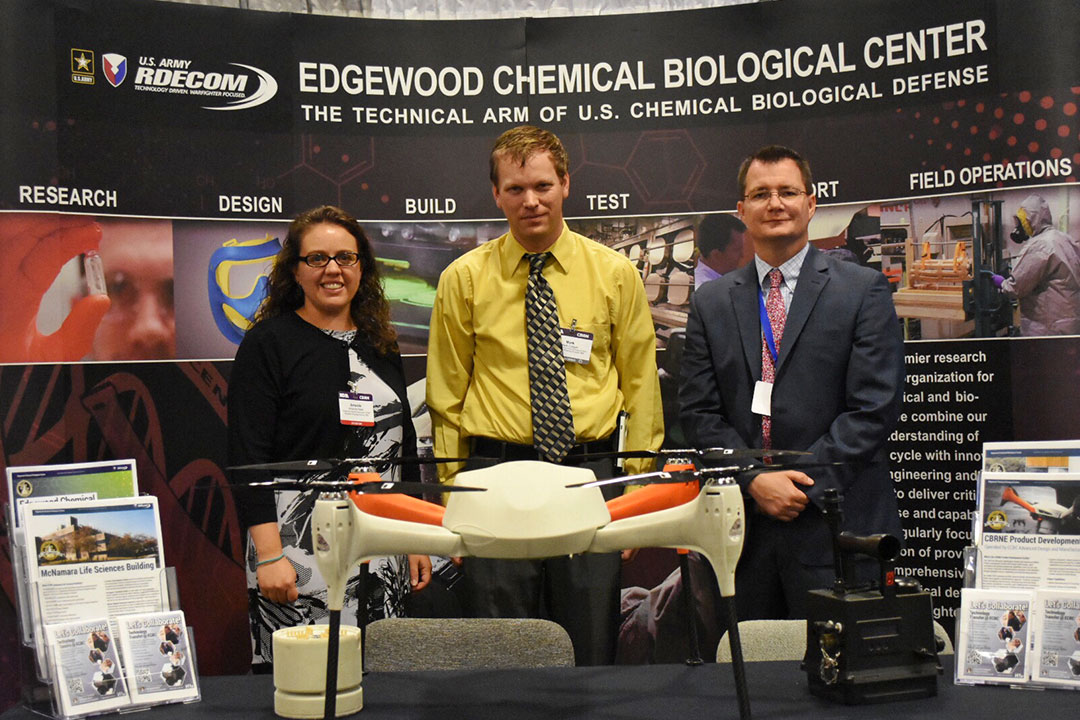// NEWS RELEASE
RDECOM C&B Center Director Addresses Future of CB Defense
CCDC Chemical Biological Center Public Affairs | August 2nd, 2018
RDECOM C&B Center Director Addresses Future of CB Defense
DEVCOM CBC Public AffairsAugust 2nd, 2018

RDECOM C&B Center Director Eric Moore, Ph.D., speaks at the annual NDIA CBRN Defense Conference about technology and innovation in development to support the CBRN community.
U.S. Army Research, Development and Engineering Command Chemical & Biological (RDECOM C&B) Center Director Eric Moore, Ph.D., addressed members of military, government, industry and academia about the future of chemical and biological defense during this year’s CBRN Defense Conference and Exhibition hosted by the National Defense Industrial Association (NDIA) in Wilmington, Del.
With a focus on the Army’s modernization priorities, the annual CBRN Defense Conference and Exhibition provided an opportunity for attendees to learn from key leaders about acquisition requirements and partnership opportunities across the CBRN support spectrum.
Moore spoke about several RDECOM C&B Center focus areas which align with the U.S. Army modernization strategy.
- Integrated early warning systems rely on detection, networking and artificial intelligence to provide actionable information to warfighters and help commanders make real-time decisions.
- Advanced obscurants will provide protection of the next generation combat vehicle and spectral dominance in future fights, allowing warfighters to be better protected in maneuver.
- Additive manufacturing provides cost-effective solutions to quickly build and repair items for warfighter use.
- Non-aqueous decontamination technologies, such as metal organic frameworks, allow warfighters and equipment to return to the fight faster after exposure.
- Increased collaboration with the 20th CBRNE Command and the U.S. Army CBRN School provides opportunities to educate warfighters on handling CB threats, and ensures that CB defense solutions address their needs.
- Synthetic biology offers the potential to unlock new types of materials by harnessing the natural abilities of living systems, such as self-assembly, sense-and-respond, and molecular-scale control and patterning.
“The future is bright,” Moore said. “We’re developing paper tickets embedded with cellular machinery that change color in response to a range of threats today, but we’re looking to the future. By 2038 we’ll incorporate life-mimicking properties, such as sense-and-respond and self-healing, into deployed systems.”
Moore also shared innovative uses of semi-autonomous systems and robotics as a force multiplier for chemical and biological reconnaissance capabilities. For example, the Center’s Deep Purple drone carrying the Array Configurable of Remote Network Sensors (ACORNS) can autonomously navigate to a CB threat cloud and transmit detection information to battlefield commanders over Army networks.
Moore highlighted a new collaborative effort occurring this fall which brings warfighters into the Center’s laboratory spaces on 30- to 45-day rotations to engage in two-way learning with scientists and engineers.
“One of the most important things we’re moving forward with is getting warfighters in the laboratory,” said Moore. “The goal is to let the warfighter see the challenges scientists face and how scientists think about capability development but more importantly, for the scientists to learn about what the warfighter needs.”
Moore concluded by stressing the importance of government-industry partnerships to help improve the greater community. “We’re in close collaboration with industry by means of the newly opened Defense Technology Commercialization (DefTech) Center, which allows for new capabilities development,” explained Moore.
The DefTech Center is a collaboration between Aberdeen Proving Ground, Harford and Cecil counties and the Maryland Commerce Department and is located in Havre de Grace. The purpose of the center is to advance the commercialization of Army technology, provide technology thrusts to Army invention, support the growth of new businesses in the region and support the area’s technological workforce.

“To keep in step with industry, we aim to increase agility and responsiveness to develop cutting-edge solutions as quickly as possible.” Moore said.
In addition to Moore’s presentation, the RDECOM C&B Center was represented in the exhibition hall where Center personnel spoke to interested parties about the capabilities of the Center. The display featured the Deep Purple drone and ACORNS package.
“Our presence at this year’s conference is important because it allows us to share our capabilities and network with potential business partners.” said Amanda Hess, the Center’s Technology Transfer Office chief.
The U.S. Army Combat Capabilities Development Command (DEVCOM) leads in the discovery, development and delivery of technology-based capabilities to enable Soldiers to win our nation’s wars and come home safely. DEVCOM is a major subordinate command of the U.S. Army Futures Command. The DEVCOM Chemical Biological Center is the Army’s principal research and development center for chemical and biological defense technology, engineering and field operations. The DEVCOM Chemical Biological Center is headquartered at Aberdeen Proving Ground, Maryland.
